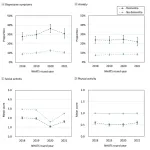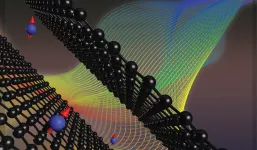(Press-News.org) A team of researchers led by Rensselaer Polytechnic Institute’s Trevor David Rhone, assistant professor in the Department of Physics, Applied Physics, and Astronomy, has identified novel van der Waals (vdW) magnets using cutting-edge tools in artificial intelligence (AI). In particular, the team identified transition metal halide vdW materials with large magnetic moments that are predicted to be chemically stable using semi-supervised learning. These two-dimensional (2D) vdW magnets have potential applications in data storage, spintronics, and even quantum computing.
Rhone specializes in harnessing materials informatics to discover new materials with unexpected properties that advance science and technology. Materials informatics is an emerging field of study at the intersection of AI and materials science. His team’s latest research was recently featured on the cover of Advanced Theory and Simulations.
2D materials, which can be as thin as a single atom, were only discovered in 2004 and have been the subject of great scientific curiosity because of their unexpected properties. 2D magnets are significant because their long-range magnetic ordering persists when they are thinned down to one or a few layers. This is due to magnetic anisotropy. The interplay with this magnetic anisotropy and low dimensionality could give rise to exotic spin degrees of freedom, such as spin textures that can be used in the development of quantum computing architectures. 2D magnets also span the full range of electronic properties and can be used in high-performance and energy-efficient devices.
Rhone and team combined high-throughput density functional theory (DFT) calculations, to determine the vdW materials’ properties, with AI to implement a form of machine learning called semi-supervised learning. Semi-supervised learning uses a combination of labeled and unlabeled data to identify patterns in data and make predictions. Semi-supervised learning mitigates a major challenge in machine learning – the scarcity of labeled data.
“Using AI saves time and money,” said Rhone. “The typical materials discovery process requires expensive simulations on a supercomputer that can take months. Lab experiments can take even longer and can be more expensive. An AI approach has the potential to speed up the materials discovery process.”
Using an initial subset of 700 DFT calculations on a supercomputer, an AI model was trained that could predict the properties of many thousands of materials candidates in milliseconds on a laptop. The team then identified promising candidate vdW materials with large magnetic moments and low formation energy. Low formation energy is an indicator of chemical stability, which is an important requirement for synthesizing the material in a laboratory and subsequent industrial applications.
“Our framework can easily be applied to explore materials with different crystal structures, as well,” said Rhone. “Mixed crystal structure prototypes, such as a data set of both transition metal halides and transition metal trichalcogenides, can also be explored with this framework.”
“Dr. Rhone’s application of AI to the field of materials science continues to produce exciting results,” said Curt Breneman, dean of Rensselaer’s School of Science. “He has not only accelerated our understanding of 2D materials that have novel properties, but his findings and methods are likely to contribute to new quantum computing technologies.”
Rhone was joined in research by Romakanta Bhattarai and Haralambos Gavras of Renselaer; Bethany Lusch and Misha Salim of Argonne National Laboratory; Marios Mattheakis, Daniel T. Larson, and Efthimios Kaxiras of Harvard University; and Yoshiharu Krockenberger of NTT Basic Research Laboratories.
About Rensselaer Polytechnic Institute:
Founded in 1824, Rensselaer Polytechnic Institute is America’s first technological research university. Rensselaer encompasses five schools, over 30 research centers, more than 140 academic programs including 25 new programs, and a dynamic community made up of over 6,800 students and 104,000 living alumni. Rensselaer faculty and alumni include upwards of 155 National Academy members, six members of the National Inventors Hall of Fame, six National Medal of Technology winners, five National Medal of Science winners, and a Nobel Prize winner in Physics. With nearly 200 years of experience advancing scientific and technological knowledge, Rensselaer remains focused on addressing global challenges with a spirit of ingenuity and collaboration. To learn more, please visit www.rpi.edu.
Contact:
Katie Malatino
Sr. Communications Specialist
malatk@rpi.edu
838-240-5691
For general inquiries: newsmedia@rpi.edu
Visit the Rensselaer research and discovery blog: https://everydaymatters.rpi.edu/
Follow us on Twitter: @RPINews
END
Rensselaer researcher uses artificial intelligence to discover new materials for advanced computing
Trevor Rhone uses AI to identify two-dimensional van der Waals magnets
2023-05-11
ELSE PRESS RELEASES FROM THIS DATE:
Having dementia and reduction in social participation are associated with increased depression and anxiety during the COVID-19 pandemic
2023-05-11
Tokyo, May 8, 2023 -- An increased risk of depression and anxiety among US older adults with dementia and poor activity participation has been demonstrated through an analysis of data from the National Health and Aging Trends Study (NHATS), a nationally representative population-based study.
These findings were reached by a team of researchers from the Tohoku University Graduate School of Medicine, Exploratory Oncology Research and Clinical Trial Center in National Cancer Center, and Tokyo Metropolitan Institute of Medical Science, Japan. This study is published in the Journal of Alzheimer’s Disease Reports 7(1).
The coronavirus disease 2019 (COVID-19) ...
Targeting uncontrolled inflammation may hold the key to treating therapy-resistant cancers
2023-05-11
GRAND RAPIDS, Mich. (May 11, 2023) — Van Andel Institute scientists have pinpointed how a specific gene mutation triggers an inflammatory cascade that may drive development of treatment-resistant cancers.
The new findings, published today in Molecular Cell, reveal for the first time the molecular circuitry by which mutations in the gene STK11 cause inflammation to spiral out of control. The resulting chemical firestorm damages healthy cells and can enable cancer development. Tumors that lose the STK11 gene are tough ...
With new experimental method, researchers probe spin structure in 2D materials for first time
2023-05-11
PROVIDENCE, R.I. [Brown University] — For two decades, physicists have tried to directly manipulate the spin of electrons in 2D materials like graphene. Doing so could spark key advances in the burgeoning world of 2D electronics, a field where super-fast, small and flexible electronic devices carry out computations based on quantum mechanics.
Standing in the way is that the typical way in which scientists measure the spin of electrons — an essential behavior that gives everything in the physical universe its structure — usually doesn’t work in 2D materials. This makes it incredibly difficult to fully understand the materials and propel forward technological ...
These sounds are out of this world! #ASA184
2023-05-11
CHICAGO, May 11, 2023 – You may know how other planets look, like the rust orange, dusty surface of Mars or the vibrant teal of Uranus. But what do those planets sound like?
Timothy G. Leighton from the University of Southampton in the U.K. designed a software program that produces extraterrestrial environmental sounds and predicts how human voices might change in distant worlds. He will demonstrate his work at the upcoming 184th Meeting of the Acoustical Society of America, running May 8-12 at the Chicago Marriott Downtown Magnificent Mile Hotel. His presentation will take place ...
New composite strategy leaves coverage questions behind, researchers report
2023-05-11
Answers could be cloudy for researchers using Landsat images to investigate the coverage of the continental United States. The National Land Cover Database (NLCD) are useful products for scientists to understand how things like tree canopy and road coverage changes over time, but something as simple as cloud coverage can be misinterpreted in the satellite images as a significant surface coverage change. How can researchers be sure they’re getting a truly representative understanding of any one area?
The answer lies in composite ...
Comparison of depression and anxiety following self-reported COVID-19–like symptoms vs SARS-CoV-2 seropositivity
2023-05-11
About The Study: In this study of more than 45,000 individuals drawn from the French general population, COVID-19–like symptoms, but not SARS-CoV-2 infection, during the first months of the pandemic were associated with an increased occurrence of subsequent depression and anxiety eight months or more after the occurrence of COVID-19–like symptoms, even when SARS-CoV-2 serologic test results were negative.
Authors: Alexandra Rouquette, M.D., Ph.D., of the Université de Versailles Saint-Quentin-en-Yvelines in Paris, is the corresponding ...
Trends in the prevalence of functional limitations among cancer survivors
2023-05-11
About The Study: The number of U.S. cancer survivors with self-reported functional limitation has more than doubled during the past 20 years, with relatively less growth in the number of limitation-free survivors.
Authors: Vishal R. Patel, B.S., of the University of Texas at Austin, is the corresponding author.
To access the embargoed study: Visit our For The Media website at this link https://media.jamanetwork.com/
(doi:10.1001/jamaoncol.2023.1180)
Editor’s Note: Please see the article for additional information, including other authors, ...
New Utah study finds antibiotic stewardship program significantly reduced prescribing rates of antibiotics at urgent care centers in promising initiative to curb antibiotic overuse
2023-05-11
Overuse of antibiotic prescriptions for patients with upper respiratory illnesses at urgent care clinics in the United States has been an ongoing challenge, but a new study led by researchers at two Utah health systems – Intermountain Health and University of Utah Health – finds that a targeted approach utilizing antibiotic stewardship practices significantly reduces overuse of these medications.
In this Centers for Disease Control and Prevention (CDC) funded study, published today in JAMA Network ...
Obesity accelerates loss of COVID-19 vaccination immunity, study finds
2023-05-11
University of Cambridge media release
Obesity accelerates loss of COVID-19 vaccination immunity, study finds
UNDER STRICT EMBARGO UNTIL 16:00 (UK TIME) / 11:00 (US ET) ON THURSDAY 11 MAY 2023
The protection offered by COVID-19 vaccination declines more rapidly in people with severe obesity than in those with normal weight, scientists at the Universities of Cambridge and Edinburgh have found. The study suggests that people with obesity are likely to need more frequent booster doses to maintain their immunity.
Clinical trials have shown that COVID-19 vaccines are highly effective at reducing symptoms, hospitalisation and deaths ...
Milk reaction inspires new way to make highly conductive gel films
2023-05-11
A common chemical reaction that most people have seen first-hand is the inspiration for a new way to make a flexible gel film that could lead to innovations in sensors, batteries, robotics and more.
A research team led by Texas Engineers developed what they call a "dip-and-peel" strategy for simple and rapid fabrication of two-dimensional ionogel membranes. By dipping sustainable biomass materials in certain solvents, molecules naturally respond by arranging themselves into functional thin films at the edge of the material that can easily be removed using nothing more than a simple set ...
LAST 30 PRESS RELEASES:
Corday Selden selected for the Oceanography Society Early Career Award
MIT chemists determine the structure of the fuzzy coat that surrounds Tau proteins
Same moves, different terrain: How bacteria navigate complex environments without changing their playbook
Severe weather is deadly for vulnerable older adults long after the storm ends, study finds
Expert panel highlights opportunities for improving cancer studies
Hearing aid prescriptions not associated with changes in memory and thinking
Seth Zippel selected for The Oceanography Society Early Career Award
Jeremy Horowitz selected for The Oceanography Society Early Career Award
Kennesaw State University’s Jerry Mack named Paul “Bear” Bryant Newcomer Coach of the Year
Ancient teeth are treasure troves of data on Iron Age lifestyles
Avocados may become easier to grow in India—but not if global emissions remain high
Pregnant women with IBD show heightened inflammation in vaginal mucosa
Underwater photos show seabirds, seals and fish interacting with a tidal turbine in Washington State
1 in 5 surveyed UK adults who have experienced the death of a pet report it as more distressing than experienced human deaths, with significant rates of prolonged grief disorder symptoms also being re
Polyester microfibers in soil negatively impact the development of cherry tomato plants in experiments, raising concerns over the potential effect of high levels of such contaminants
LGBTQ+ adults may be around twice as likely to be unemployed or to report workforce non-participation compared to heterosexual adults, per large representative Australian survey
Horses can smell fear: In experiments where horses smelled sweat from scared humans, they reacted to scary and sudden events with increased fear and reduced human interaction
New synaptic formation in adolescence challenges conventional views of brain development
Scientists identify target to treat devastating brain disease
Oliver Zielinski selected as Fellow of The Oceanography Society
Has progress stalled on gender equality at work?
Quantum simulator sheds light on how nature moves energy in systems like photosynthesis and solar conversion
Can a hashtag help prevent atrocities? Study shows social media can be a powerful tool
The American Ornithological Society (AOS) announces the winner of the 2025 Wesley Lanyon Award
Woolly rhino genome recovered from Ice Age wolf stomach
An earthquake on a chip: New tech could make smartphones smaller, faster
New research shows how AI tools are expanding individual capabilities while contracting scientific attention
A nanomaterial flex — MXene electrodes help OLED display technology shine, while bending and stretching
Global research team uncovers mechanism by which metabolites guide cellular decisions
Work hours, stress, and burnout among resident physicians
[Press-News.org] Rensselaer researcher uses artificial intelligence to discover new materials for advanced computingTrevor Rhone uses AI to identify two-dimensional van der Waals magnets







